CHRIS DUKE, DVM
Q. I’m a big believer in heartworm prevention, but I find myself repeating my “heartworm 101” lecture over and over to clients. Is it worth it?
A. A time-tested principle of marketing is what’s called the “Rule of 7”—the idea that people need to hear a message seven times before they act on it. While seven may not be your magic number, the bottom line is that the
Q. Why do clients need to hear the same message so many times?
A. Comprehension is built in stages. It starts with awareness that heartworm is a serious disease, then clients need to understand what heartworms can do to their pets. They should also have a grasp of the heartworm life cycle and vectors, as well as know how heartworm preventives work. Until full comprehension is achieved, many clients may not see the need for heartworm prevention. It takes time.
Other factors to consider:
- No two clients are alike—while some hear your recommendations as gospel, others may be skeptical and seek more proof.
- Clients don’t hear your words in a vacuum. New pet owners may be thinking about everything from pet food to neutering to house training, with heartworm disease lower on their list of concerns.
- Keep the message simple and always ask if they have questions.
- Heartworm education shouldn’t be overlooked with owners who already give their pets preventives. Reinforcing good behavior can be as important as initiating it.
Q. I don’t have time to tell each client the same thing seven times. What are my alternatives?
A. The good news: you can repeat the message without always being the mouthpiece, and not every communication needs to be a conversation. The educational process may start with a brochure in the waiting room and a poster in the exam room. Next, the technician can ask about heartworm prevention
while taking the pet’s history and share how he or she protects her own dogs and cats. By the time you walk in the room and recommend a heartworm test, the repeated messages about heartworm prevention may be starting to resonate. Education doesn’t stop when the client leaves your clinic. You can promote articles on your practice website, post on your clinic Facebook page or blog about the need for heartworm prevention. Collectively, these messages are key to promoting better compliance.
Is it better to show— or tell—my clients?
The medical profession has come to understand that different patients/consumers have different learning styles. Here’s how heartworm edu- cation can be adapted:
Visual. Show an owner a diagram of the heartworm life cycle. Play an educational video in the waiting room. Display a preserved infected heart in a jar or an artificial model.
Auditory. Clients who learn by listening may be partic- ularly inspired by stories or examples from you or your staff members.
Written. Written materials are particularly effective as take-home communication, since owners may easily be overwhelmed by everything they hear during a veterinary visit. Reading also allows pet owners learn at their own pace.







